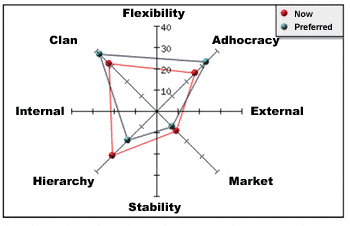In my earlier blog post I discussed how to use Change Circles for Organization Development and Change. We discussed Scharmer’s 3 levels of conversation that determine innovation and organizational performance: Downloading, Debate and Dialogue. Let’s continue with an example of organization development through dialogue and change circles.
Practicing Dialogue
One of the organizations I was working with, decided to start its development in change circles by doing a one-day workshop on Dialogue and Feedback with each circle. This would help them practice because their current culture is far away from dialogue.

They have an internally focused culture based on the people-oriented Clan Culture type and the process-oriented Hierarchy Culture type in OCAI’s Competing Values Framework.
Until recently, they didn’t need an external focus to service their customers and anticipate global, digital developments that cause a revolution in their work. But to succeed in the future, they need to move to this right-hand side of the framework...
One of their shared behaviors (a dark side of too much Clan Culture) is keeping it nice and not speaking your mind in public or in meetings – but instead: complain and gossip in the hallways (Scharmer’s Talking Nice – level 1 conversation – “Silence”). Talking about people, not talking to people. So they are swamped with meetings that are mostly rituals – because they don’t really talk things through and thus they don’t achieve inspired action.
The other dominant behavior seems to derive from the dark side of over-stressed Hierarchy Culture: they need to get things done, so when people don’t act or keep complaining, executives and team leaders use their position power. They start to “push and pull” people, have disciplinary one-on-ones and push during decision-making meetings. The managing team erupts into fierce debate every now and then and the best debater wins the battle – which doesn’t mean that the best decision is made. The former CEO was kind of a bully – and employees still project this image unto the current executives. They don’t trust leaders and fear them. This is Scharmer’s Talking Tough – level 2 conversation – “Violence”).
Personal and collective learning: Dialogue
Both level 1 and 2 conversation levels will not help to build trust and safety, which are required to reach true consensus and alignment towards a new, emerging reality of a 24/7 high service organization. They need to develop a level 3 conversation: a dialogue throughout the organization to reach consensus and to empower and include employees to make a change... But that’s not easy because many employees don’t trust leadership and are afraid. Many people also suffer from cynism (change fatigue) and they’ve had patronizing leaders for years (keeping them small and into a “victim” story where “they” – the management – are the bad guys).
The managing team decided to start with a one-day workshop to start each change circle. This way, all employees reflect on their attitude, learn how to do dialogue and practice the skill to give and receive feedback – which would change the organization’s culture once enough people would do it. Giving and receiving feedback is probably the new behavior that will make the biggest difference in the organization.
Open mind: Observations versus Interpretations
The workshop contained a model to help people see their fears and inner critic – and to build their courage to protect themselves from being hurt. We also included exercises that helped people see how they differed and how to respect those individual viewpoints.
We practiced the difference between perceiving and judging. We practiced to see what was an observation of a fact - as opposed to what was our interpretation, a projection, an expectation or prejudice. “I noticed you were late this morning” is an observation. “You have a lousy work ethic” is an interpretation.
We trained to be calm and see what this moment was presenting, then respond mindfully, using dialogue techniques. All the while, the circle of trusted colleagues formed a dialogue circle and more and more people spoke their minds.
World Cafe and ongoing Circles
This one day was a great practice, but the proof of the pudding is in Doing it “in real life” and Persistence. The circles will meet again to discuss progress and to practice and support each other. People decided to coach one another and get together with a coworker to practice situations and solve difficulties. But they were still doubtful about the executives. Would the managing team really apply this? Would they be open to feedback and genuine dialogue?
To build trust, to see the whole system (instead of your own team and circle only) and practice the “new openness and dialogue”, we’re planning a world café session. Everyone will meet in small café tables (4-5 persons) for 3 rounds of dialogue with different people each round, to have a dialogue about how to better work together across all levels and teams and how to serve the clients better, including everyone’s contribution. Together, they will focus on how to shift their culture to the right-hand side of the culture types. They work towards an external focus, towards being open-minded, and becoming more innovative, responsive, creative and competitive. This inclusive dialogue is essential to help their system gain trust and change together.
Marcella Bremer MScBA